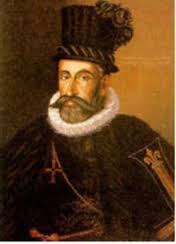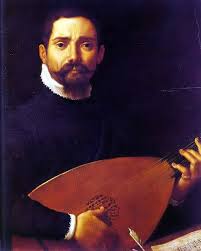June 24, 2013.Andrea and Giovanni Gabrieli.Yet again we’re celebrating composers whose birthdays remain unknown to music historians, but who were very important to the development of the Western musical tradition.Andrea Gabrieli, a Venetian, was born around 1532.If that’s the case (some other sources place his birth earlier, in the 1520s), he was seven years younger than Palestrina and about the same age as Orlando di Lasso.At the time, Franco-Flemish composers were the leading creative force in Italy, and there’s some evidence that Andrea took lessons from one of them, Adrian Willaert, who is considered the founder of the Venetian School of music.From Willaert he learned how to write polyphonic music.He spent some time in Verona and then returned to Venice and settled in Cannaregio, the northern district of the city (the area where the first Jewish Ghetto was created at the beginning of the century).Around 1555 he competed, unsuccessfully, for the position of an organist at the San Marco.In 1562 he traveled to Germany and while in Munich met Orlando di Lasso.Both men benefited from this relationship, exchanging ideas and learning from each other.In 1564 Gabrieli returned to Venice and in 1566 received the coveted position of an organist at the San Marco cathedral (as the second organistuntil 1584, when he was promoted to the position of the first organist).His duties at San Marco included composing, and not just the church music but also music for official ceremonies.For example, he wrote music for the celebrations of the historic victory of the Venetian fleet over the Ottoman Turks at Lepanto in 1571.Later in his life Andrea became a teacher.His most famous pupil was his own nephew, Giovanni.Here is Andrea Gabrieli’s Magnificat for three choirs; it’s performed by ensemble Chanticleer.
Giovanni, the more famous of the Gabrielis, was also born in Venice sometime between 1554 and 1557.As a youth he studied with his uncle, whom he revered and who was a father figure for Giovanni.Later, between 1575 and 1579, also following in the steps of his uncle, he went to Germany to study with Orlando di Lasso in Munich.He returned to Venice in 1584 and succeeded Andrea as the second organist at the San Marco.Soon after he became the principal organist at the Scuola Grande di San Rocco, one of the most influential confraternities in Venice (today it’s mostly famous for its magnificent frescoes by Tintoretto, who was still working on them at the time of Gabrieli’s employ).Like his uncle, Giovanni also became an important teacher: one of his pupils was Heinrich Schütz, who became a major early Baroque composer, probably the most significant German composer before Johann Sebastian Bach.Giovanni composed a large number of purely instrumental music (for example, his Sacrae symphoniae) and a large number of choral motets.His fame spread all over Italy, on par with Palestrina’s; one ruled the music world of Rome, the other – in Venice.Gabrieli, who in his last years was often sick and could not perform his duties at the Cathedral, died on April 12, 1612, in Venice.We’ll hear Giovanni Gabrieli’s In Ecclesiis.It was written in a typical Venetian ”polychoral” manner, that is to be performed by several choirs.It was also written specifically for the Cathedral of San Marco: each choir was to occupy a separate position in this magnificent church.It is performed (here) by the Choir of King's College and Philip Jones Brass Ensemble.
Andrea and Giovanni Gabrieli 2013
June 24, 2013. Andrea and Giovanni Gabrieli. Yet again we’re celebrating composers whose birthdays remain unknown to music historians, but who were very important to the development of the Western musical tradition. Andrea Gabrieli, a Venetian, was born around 1532. If that’s the case (some other sources place his birth earlier, in the 1520s), he was seven years younger than Palestrina and about the same age as Orlando di Lasso. At the time, Franco-Flemish composers were the leading creative force in Italy, and there’s some evidence that Andrea took lessons from one of them, Adrian Willaert, who is considered the founder of the Venetian School of music. From Willaert he learned how to write polyphonic music. He spent some time in Verona and then returned to Venice and settled in Cannaregio, the northern district of the city (the area where the first Jewish Ghetto was created at the beginning of the century). Around 1555 he competed, unsuccessfully, for the position of an organist at the San Marco. In 1562 he traveled to Germany and while in Munich met Orlando di Lasso. Both men benefited from this relationship, exchanging ideas and learning from each other. In 1564 Gabrieli returned to Venice and in 1566 received the coveted position of an organist at the San Marco cathedral (as the second organistuntil 1584, when he was promoted to the position of the first organist). His duties at San Marco included composing, and not just the church music but also music for official ceremonies. For example, he wrote music for the celebrations of the historic victory of the Venetian fleet over the Ottoman Turks at Lepanto in 1571. Later in his life Andrea became a teacher. His most famous pupil was his own nephew, Giovanni. Here is Andrea Gabrieli’s Magnificat for three choirs; it’s performed by ensemble Chanticleer.
At the time, Franco-Flemish composers were the leading creative force in Italy, and there’s some evidence that Andrea took lessons from one of them, Adrian Willaert, who is considered the founder of the Venetian School of music. From Willaert he learned how to write polyphonic music. He spent some time in Verona and then returned to Venice and settled in Cannaregio, the northern district of the city (the area where the first Jewish Ghetto was created at the beginning of the century). Around 1555 he competed, unsuccessfully, for the position of an organist at the San Marco. In 1562 he traveled to Germany and while in Munich met Orlando di Lasso. Both men benefited from this relationship, exchanging ideas and learning from each other. In 1564 Gabrieli returned to Venice and in 1566 received the coveted position of an organist at the San Marco cathedral (as the second organistuntil 1584, when he was promoted to the position of the first organist). His duties at San Marco included composing, and not just the church music but also music for official ceremonies. For example, he wrote music for the celebrations of the historic victory of the Venetian fleet over the Ottoman Turks at Lepanto in 1571. Later in his life Andrea became a teacher. His most famous pupil was his own nephew, Giovanni. Here is Andrea Gabrieli’s Magnificat for three choirs; it’s performed by ensemble Chanticleer.
Giovanni, the more famous of the Gabrielis, was also born in Venice sometime between 1554 and 1557. As a youth he studied with his uncle, whom he revered and who was a father figure for Giovanni. Later, between 1575 and 1579, also following in the steps of his uncle, he went to Germany to study with Orlando di Lasso in Munich. He returned to Venice in 1584 and succeeded Andrea as the second organist at the San Marco. Soon after he became the principal organist at the Scuola Grande di San Rocco, one of the most influential confraternities in Venice (today it’s mostly famous for its magnificent frescoes by Tintoretto, who was still working on them at the time of Gabrieli’s employ). Like his uncle, Giovanni also became an important teacher: one of his pupils was Heinrich Schütz, who became a major early Baroque composer, probably the most significant German composer before Johann Sebastian Bach. Giovanni composed a large number of purely instrumental music (for example, his Sacrae symphoniae) and a large number of choral motets. His fame spread all over Italy, on par with Palestrina’s; one ruled the music world of Rome, the other – in Venice. Gabrieli, who in his last years was often sick and could not perform his duties at the Cathedral, died on April 12, 1612, in Venice. We’ll hear Giovanni Gabrieli’s In Ecclesiis. It was written in a typical Venetian ”polychoral” manner, that is to be performed by several choirs. It was also written specifically for the Cathedral of San Marco: each choir was to occupy a separate position in this magnificent church. It is performed (here) by the Choir of King's College and Philip Jones Brass Ensemble.
father figure for Giovanni. Later, between 1575 and 1579, also following in the steps of his uncle, he went to Germany to study with Orlando di Lasso in Munich. He returned to Venice in 1584 and succeeded Andrea as the second organist at the San Marco. Soon after he became the principal organist at the Scuola Grande di San Rocco, one of the most influential confraternities in Venice (today it’s mostly famous for its magnificent frescoes by Tintoretto, who was still working on them at the time of Gabrieli’s employ). Like his uncle, Giovanni also became an important teacher: one of his pupils was Heinrich Schütz, who became a major early Baroque composer, probably the most significant German composer before Johann Sebastian Bach. Giovanni composed a large number of purely instrumental music (for example, his Sacrae symphoniae) and a large number of choral motets. His fame spread all over Italy, on par with Palestrina’s; one ruled the music world of Rome, the other – in Venice. Gabrieli, who in his last years was often sick and could not perform his duties at the Cathedral, died on April 12, 1612, in Venice. We’ll hear Giovanni Gabrieli’s In Ecclesiis. It was written in a typical Venetian ”polychoral” manner, that is to be performed by several choirs. It was also written specifically for the Cathedral of San Marco: each choir was to occupy a separate position in this magnificent church. It is performed (here) by the Choir of King's College and Philip Jones Brass Ensemble.